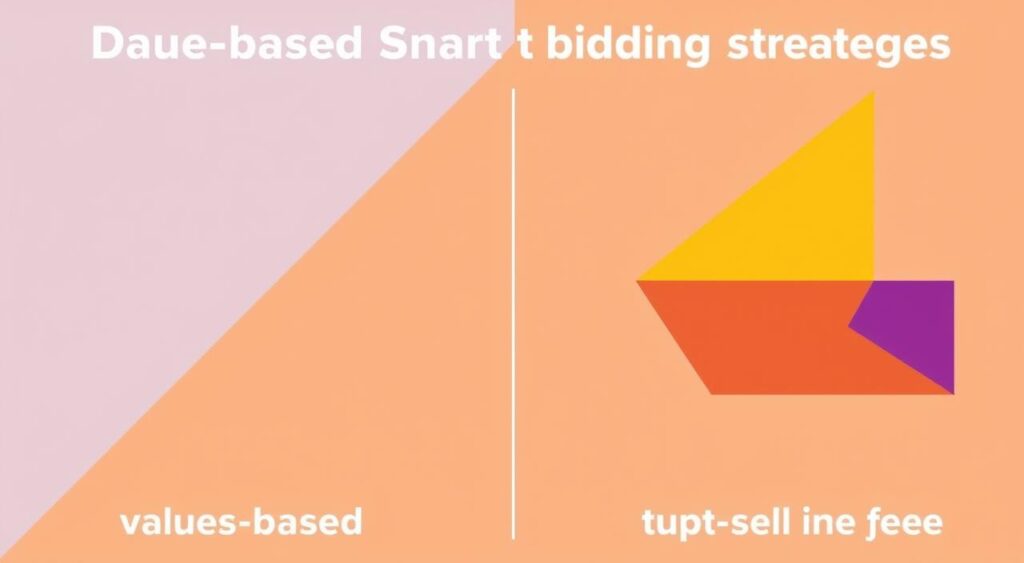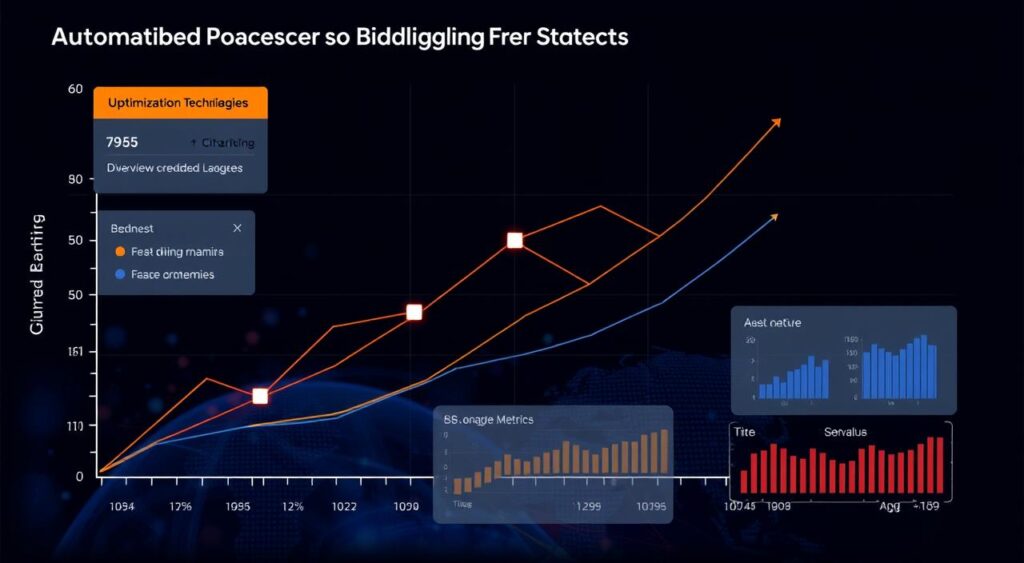Are you looking to make the most of your Google Ads? Value-based smart bidding strategies can help. They focus on the value of each conversion, not just the cost. This approach can help you reach your goals and stay competitive in India.
It’s important to understand value-based strategies to make smart choices for your ads. With these strategies, you can optimize your bids to increase the value of each conversion. This way, you can get more from your ad spend and see real results for your business. What are two types of value-based smart bidding strategies that can help you achieve your goals?

When choosing value-based smart bidding strategies, think about what aligns with your business goals. The right strategy can lead to more conversions, revenue, and growth. What is value based strategy that can help you succeed in the competitive Indian market?
Key Takeaways
- Value-based smart bidding strategies focus on the value of each conversion, rather than just the cost.
- There are two types of value-based smart bidding strategies that can help you achieve your goals.
- Understanding what is value based strategy is crucial to making informed decisions about your ad campaigns.
- Value-based smart bidding strategies can help you maximize the impact of your ads and get the most out of your budget.
- Choosing the right value-based smart bidding strategy can drive more conversions, revenue, and growth for your business.
- What are two types of value-based smart bidding strategies that can help you succeed in the Indian market?
Understanding Value-Based Smart Bidding in Google Ads
Exploring Google Ads, you’ll find many ways to boost your bids and campaign results. Value-based smart bidding is a key concept. It uses machine learning to set bids based on each conversion’s value. To create a value strategy, you must think about strategy alternatives and their effects on your campaign.
Smart bidding offers several methods to consider. For example, using what are two smart bidding strategies that jamelle can help increase your return on ad spend (ROAS). These strategies help you use your budget wisely and reach your business goals.
Here are important points for a value-based smart bidding strategy:
- Know your campaign goals and objectives
- Set up conversion tracking to measure each conversion’s value
- Use machine learning algorithms to optimize bids based on conversion value
By following these steps, you can make a value-based smart bidding strategy that boosts your business. Always keep an eye on and tweak your campaign to get the best from your ad spend.
With the right strategy, you can fully use value-based smart bidding. This will take your Google Ads campaigns to the next level.
Target ROAS: The First Value-Based Strategy
Understanding Target ROAS is key when using value-based bidding strategies. It lets you set a specific return on ad spend (ROAS) goal. This way, you can optimize your bids for the highest revenue. It’s great for focusing on conversions that add the most value to your business.
There are two main types of value streams for better bidding: revenue-driven and customer-driven. Revenue-driven aims to increase revenue. Customer-driven focuses on getting and keeping customers. Knowing these helps tailor your strategy to your business goals.
To maximize Target ROAS, knowing your business goals and conversion value is crucial. Setting a target ROAS ensures your bids support your business growth. This leads to more revenue and growth.
- Set a specific ROAS goal
- Optimize your bidding strategy for maximum revenue
- Monitor and adjust your performance metrics regularly
By following these steps and using value-based bidding, you can make your bidding strategy more effective. This drives real results for your business.
Maximize Conversion Value: The Second Approach
Exploring value-based smart bidding strategies, you’ll find Maximize Conversion Value is powerful. It optimizes bids to increase total conversion value, not just conversions. This is one of the two types of bidding available for trueview.
To start with Maximize Conversion Value, learn about two types of value streams in safe and how they apply to your business. This knowledge helps set up your first campaign and track performance.
How Maximize Conversion Value Works
Maximize Conversion Value uses machine learning to analyze conversion data and adjust bids. It considers the value of each conversion to maximize return on ad spend.
Setting Up Your First Campaign
To set up your first campaign with Maximize Conversion Value, follow these steps:
- Define your conversion goals and assign values to each conversion type
- Set up your campaign with the Maximize Conversion Value bidding strategy
- Monitor your campaign’s performance and adjust your bids as needed
Monitoring Performance Metrics
After your campaign starts, watch your performance metrics closely. Focus on conversion value, cost per conversion, and return on ad spend. This helps make informed decisions and improve your campaign.
Key Differences Between Target ROAS and Maximize Conversion Value
When choosing value-based smart bidding strategies, you have two main options: Target ROAS and Maximize Conversion Value. Knowing the different types and kinds of strategies helps you decide. Target ROAS aims for a specific return on ad spend. Maximize Conversion Value seeks to increase the total conversion value.
The main differences between these strategies are:
- Target ROAS is best for businesses with a fixed budget and clear return on ad spend goals.
- Maximize Conversion Value is great for businesses aiming to boost their conversion value, without a specific return target.
- Target ROAS needs precise bidding to hit a specific return on ad spend.
- Maximize Conversion Value offers more flexibility in bidding, focusing on total conversion value.
Understanding the differences between Target ROAS and Maximize Conversion Value helps you pick the right strategy. What are different types of strategy and what are the different kinds of strategies guide you to optimize your smart bidding approach.
Prerequisites for Implementing Value-Based Smart Bidding
To start with value-based smart bidding, you need to meet some basics. Knowing about market strategies and campaign types is key. Also, understanding your audience and market trends is important for good decisions.
When you’re ready to use value-based smart bidding, consider a few things. These include:
- Required account history: You need a good account history for value-based smart bidding. This means having enough conversions and a steady conversion rate.
- Conversion tracking setup: You must have a good conversion tracking setup. This means setting up tracking codes and making sure they work right.
- Budget considerations: You need a big enough budget for value-based smart bidding. Your budget should cover campaign costs and still make a profit.
Knowing these basics and understanding market strategies and campaign types helps you succeed with value-based smart bidding.
Value-based smart bidding is a great way to boost your return on investment. It uses machine learning to optimize bids, helping you get the most from your budget. So, take the time to learn these basics and start with value-based smart bidding today.
Read More: What does Performance Planner automatically do?
Optimizing Your Value-Based Bidding Strategy
Understanding what are the three types of bidding is key to optimizing your strategy. This knowledge helps you make smart choices and reach your business goals. The three types are cost-per-click, cost-per-thousand impressions, and cost-per-conversion.
To improve your strategy, keep an eye on your performance metrics. Track your return on ad spend, conversion rates, and cost per conversion. This way, you can spot areas to get better and make decisions based on data.

- Set realistic targets and bids
- Regularly check and tweak your strategy
- Use data and analytics to guide your choices
By following these tips and knowing what are the three types of bidding, you can craft a strategy that boosts your business’s success.
Common Challenges and Solutions in Value-Based Bidding
Exploring value-based smart bidding strategies can lead to common challenges. These can affect your campaign’s success. It’s key to know these challenges and find ways to solve them to meet your business goals. Value-based bidding helps optimize bids and boost return on ad spend.
Challenges include low conversion rates and inaccurate conversion tracking. To tackle these, adjust your bidding and refine tracking. This can enhance your campaign’s performance and ROI.
Here are tips to fix performance issues and tweak your strategy:
- Keep an eye on your campaign’s performance to spot areas for betterment.
- Refine your targeting to reach the right audience.
- Adjust bids to optimize your return on ad spend.
By using these tips and understanding value-based smart bidding, you can beat common challenges. Stay updated with best practices and keep refining your strategy for better results.
| Challenge | Solution |
|---|---|
| Low conversion rates | Refine targeting options and adjust bid amounts |
| Inaccurate conversion tracking | Verify conversion tracking setup and ensure accurate data |
Best Practices for Indian Markets
In Indian markets, value-based smart bidding strategies are key. Knowing what are two smart bidding strategies that jamelle can guide you. For example, when is the best time to use value-based bidding to boost your return on ad spend (ROAS)?
The digital scene in India is complex, with different consumer habits. To thrive, you must adapt to the local market. Regional optimization tips can enhance your campaign’s success. Here are some tips:
- Language targeting: India’s diverse population speaks many languages. It’s crucial to target the right ones to reach your audience.
- Cultural sensitivity: Make sure your ads resonate with the Indian audience, being culturally relevant and sensitive.
- Mobile optimization: Since most Indians use mobiles for internet access, optimize your ads for mobile.
Read More: What are Three Signals Broad Match Uses to Match Search ads with queries?
By applying these strategies and using value-based bidding wisely, you can boost your campaign’s performance. This will help you meet your business goals in India. Keep up with the latest trends and best practices to outdo your competitors.

Adopting these best practices and staying current with value-based smart bidding can significantly increase your ROI. This will lead to success in the Indian market.
| Strategy | Description |
|---|---|
| Target ROAS | Targets a specific return on ad spend (ROAS) for your campaigns. |
| Maximize Conversion Value | Maximizes the total conversion value while meeting or exceeding your target ROAS. |
Conclusion: Making Value-Based Smart Bidding Work for Your Business
Value-based smart bidding, like Target ROAS and Maximize Conversion Value, is a strong tool for improving your Google Ads. It helps you focus on the real value of your conversions. This way, you can get more out of your ad spending.
To use value-based smart bidding well, you need to know your conversion values and track them accurately. You also need enough data from the past. Keep an eye on your performance, adjust your strategy when needed, and use insights specific to India to improve your approach.
The success of value-based smart bidding depends on giving Google’s algorithms the right data. By doing this, you can make your digital advertising more efficient and profitable.
FAQ
What are two types of value-based smart bidding strategies?
Google Ads offers two main value-based smart bidding strategies. Target ROAS and Maximize Conversion Value are these strategies. They use machine learning to optimize bids, focusing on conversion value, not just cost.
What is value-based strategy?
A value-based strategy focuses on the value each conversion brings, not just the cost. It uses machine learning to adjust bids for better ad impact.
What is strategy alternatives?
Strategy alternatives in Google Ads include different bidding methods. Besides value-based strategies, you can use manual bidding, target CPA, and target impression share.
What are two smart bidding strategies that Jamelle can use?
Jamelle can use Target ROAS and Maximize Conversion Value for smart bidding. These strategies help maximize ad spend return and focus on conversion value.
When should you use value-based bidding strategies?
Use value-based strategies when you have enough conversion data. They work best when you know the value of each conversion for your business.
What are two types of value streams?
Value streams include transaction-based and non-transaction-based types. Transaction-based streams are tied to sales or conversions. Non-transaction-based streams focus on actions like lead generation or engagement.
What are the two types of bidding available for TrueView?
TrueView video ads offer CPV and tCPA bidding. CPV bids per view, while tCPA aims for a target cost-per-action, like a conversion.
What are two types of value streams in SAP?
SAP value streams are customer and internal types. Customer value streams aim to deliver value to external customers. Internal value streams improve internal processes and operations.
What are different types of strategy?
Strategies include business, marketing, competitive, and functional types. They can be corporate, business, or functional-level strategies.
What are the different kinds of strategies?
Strategies include competitive, growth, and defensive types. Competitive strategies are cost leadership, differentiation, and focus. Growth strategies are market penetration, market development, and product development. Defensive strategies are retrenchment and divestment.
What are market-based strategies?
Market-based strategies focus on the external environment and market. They involve analyzing competition, understanding customer needs, and positioning the business to compete effectively.
Which two types of campaigns do bid strategy affect?
Bid strategy affects search and display campaigns in Google Ads. The choice of strategy, like Target ROAS or Maximize Conversion Value, impacts campaign performance and results.
What are the three types of bidding?
Google Ads has three bidding types: manual, automated, and target bidding. Manual bidding sets your own bids. Automated bidding uses machine learning. Target bidding, like Target ROAS and Maximize Conversion Value, aims for specific goals.
𝐒𝐰𝐚𝐠𝐚𝐭 𝐆𝐚𝐰𝐚𝐝𝐞
Digital Marketer | Content Creator | Growth Strategist
With 2 years of hands-on experience in the dynamic world of digital marketing, Swagat Gawade specializes in crafting compelling strategies that drive growth and engagement. From managing ad campaigns to optimizing SEO, Swagat has a proven track record of boosting brand visibility and achieving measurable results.
Key skills:
𝐒𝐨𝐜𝐢𝐚𝐥 𝐌𝐞𝐝𝐢𝐚 𝐌𝐚𝐫𝐤𝐞𝐭𝐢𝐧𝐠: Building impactful campaigns that resonate with audiences.
𝐂𝐨𝐧𝐭𝐞𝐧𝐭 𝐌𝐚𝐫𝐤𝐞𝐭𝐢𝐧𝐠: Creating engaging, high-quality content tailored to target markets.
𝐒𝐄𝐎 & 𝐒𝐄𝐌 𝐄𝐱𝐩𝐞𝐫𝐭𝐢𝐬𝐞: Ensuring brands rank high and stay competitive in search results.
𝐀𝐧𝐚𝐥𝐲𝐭𝐢𝐜𝐬 𝐏𝐫𝐨𝐟𝐢𝐜𝐢𝐞𝐧𝐜𝐲: Leveraging data to refine strategies and enhance ROI.
Swagat’s passion for learning fuels a constant pursuit of innovative marketing solutions, making him a valuable asset in today’s fast-evolving digital landscape.


